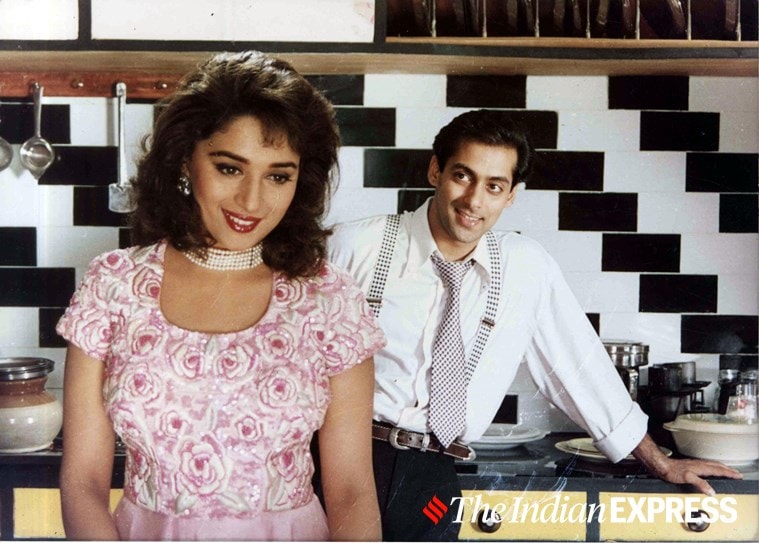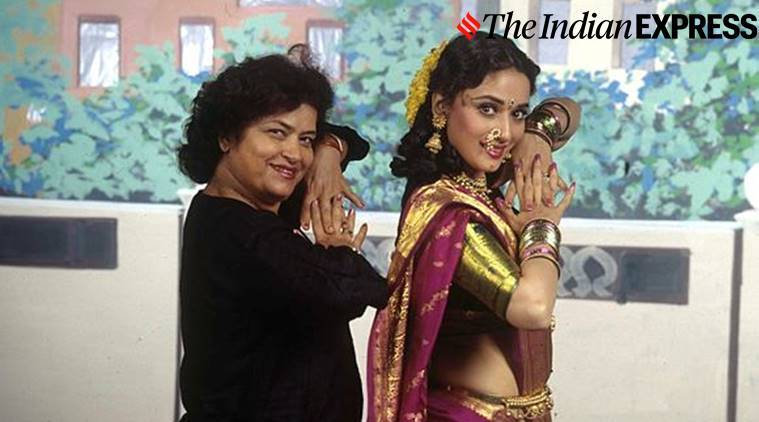[ad_1]
When Anupam Kher revealed in 2015 that Madhuri Dixit was given a higher remuneration than Salman Khan in Hum Aapke Hain Koun, barely anyone was surprised. By 1994, Madhuri was already a superstar, a self-made icon who was arguably among one of the biggest success stories of Bollywood. She was 27 and had already delivered blockbusters like Tezaab, Ram Lakhan, Tridev, Parinda, Dil, Saajan, Beta, and Khalnayak. Madhuri was the reigning queen of box office and everything she touched turned to gold.
It was Rajshri Productions that introduced Madhuri in Bollywood with Abodh (1984) at the age of 17. Though the film was panned, she got noticed. After some forgettable movies, Tezaab happened. And there she was, like a female Pied Piper, leading an entire generation to the tunes of “Ek Do Teen”. She breathed life into Nisha, the heart and soul of HAHK too, just the way she did for innocent Pooja in Saajan and the spirited Suru/Saraswati in Beta.
In 2000, Madhuri won the title of Actress of the Millennium. Guinness Book of Records Millennium version even named her as the highest paid Indian actress.
 Madhuri Dixit and Salman Khan’s crackling chemistry in Hum Aapke Hain Koun was one of the high points of the blockbuster. (Photo: Express Archives)
Madhuri Dixit and Salman Khan’s crackling chemistry in Hum Aapke Hain Koun was one of the high points of the blockbuster. (Photo: Express Archives)
What exactly was it about Madhuri that made her the numero uno star?
Madhuri came when another diva, Sridevi was ruling Bollywood in the 1980s. Even after four decades, fans are divided into Team Sridevi and Team Madhuri. The fact remains that she did replace Bollywood’s Chandni in the 1990s. Even the Khans, whose star was on the rise in the days, understood her power. Aamir and Madhuri were equals in Dil, not just onscreen, but off it too. Shah Rukh Khan romanced her with the same intensity as she reciprocated in Dil Toh Pagal Hai. And HAHK was the last film Salman did opposite an actress who suited his age!
Seen closely, that was a time when female actors were meant to adorn the screen, shed tears, dance around with the hero and shout “bachaao” at the villain’s den. Madhuri made her choices clear. Most of her films had her playing strong characters, who weren’t ready to budge. They were aggressive, tough, stubborn, bold and took their charge of their life, women who we hadn’t seen on our screens.
When she wrecked vengeance on Vijay (SRK) in Anjaam, it was no love story. She became a warrior against her male-dominated village and the oppression in Mrityudand. She took unconventional decisions in Gulaab Gang and Aaja Nachle.
Many would say Madhuri Dixit just got lucky to be at the right place at the right time. I would disagree. She’s a complete package of talent, onscreen presence, a radiant smile, chemistry with her co-actors, and delivers a near-perfect act in almost every genre. Many also point that Madhuri could never match Sridevi’s comic timing, but she compensated that with her dancing prowess, something no actress has come even close to, till now (not even Aishwarya Rai in “Dola Re”).
And can we not call her songs, the spine of her films? A major share in the success of Madhuri can be given to her iconic numbers, and her mentor, late choreographer Saroj Khan. Upon the latter’s demise last year, Madhuri said, “Saroj ji was part of my journey since the beginning. She taught me a lot, not just about dance but so much more.”
Saroj Khan designed hook steps especially for Madhuri. Each song they did together was a piece of art. Nobody could present Madhuri better than her ‘master ji’, be it “Humko Aaj Kal Hai”, “Chane Ke Khet Mein” or “Mera Piya Ghar Aaya”.
Madhuri’s nimble feet gave us dozens of tracks we’ve grown up on. But, we can’t just call her songs, dance numbers. They took the story forward. Sometimes, they were trendsetters. Her “Choli Ke Peeche Kya Hai” from Khalnayak turned heads for its bold composition and lyrics. And she pulled it off with utmost grace. She did so even in “Dhak Dhak Karne Laga” from Beta, one of the most sensuous songs till date, which also made her ‘Dhak Dhak girl’ for life.
 Saroj Khan has a huge share in the success of Madhuri Dixit. (Photo: Express Archive)
Saroj Khan has a huge share in the success of Madhuri Dixit. (Photo: Express Archive)
During one of the episodes of the Indian version of So You Think You Can Dance in 2016, Madhuri spoke about her initial days. She shared, “Those were my early struggling days and I used to feel I don’t actually fit into the ‘perfect’ size of heroines back then in Bollywood. And I used to think that way majorly because of the continuous criticisms I used to face from outsiders. But that didn’t deter my path to success and I worked hard and I think I have accomplished what I had set out for.”
One can easily look at the bright side of her statement. If she did not fit into the frame of heroines back then, she created a new frame that others were forced to fit into. There has not been a replacement for Madhuri yet.
Madhuri Dixit is a recipient of Padma Shri. She has so far won six Filmfare Awards and has featured seven times on Forbes India’s Celebrity 100 list.
Happy birthday, Madhuri Dixit!
[ad_2]
Source link